|
Day 2. Botanical Gardens, fly in to the Rupununi and drive to Iwokrama
This morning we will see dawn rise over the beautiful, expansive Botanic Garden, where, if we are lucky, the trip's first ornithological highlight will be the Blood-colored Woodpecker, an astonishingly colorful Veniliornis found only in the Guianas and even there almost wholly limited to the narrow coastal plain. The gardens host Snail Kite, Gray Hawk, Pearl Kite, Carib Grackle, Red-bellied Macaw, Red-shouldered Macaw and a host of parrots including the Orange-winged and Yellow-crowned Parrot and the Mealy Parrot. We will walk on trails in the back on the gardens and may see Toco Toucan, Yellow-chinned Spinetail, Cinereous Becard, Short-tailed Swift, Ruddy Ground Dove, Grayish Saltator, Silver-beaked Tanager, Buff-breasted Wren, and Ashy-headed Greenlet. You may also see the Golden-spangled Piculet, White-bellied Piculet, Spotted Tody-Flycatcher, Pied Water-Tyrant, Pinnated Bittern, Wing-barred Seedeater and Brown-throated Parakeet. Iwokrama River Lodge BLD
|
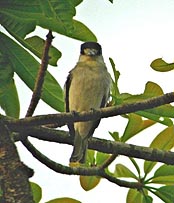
Cinereous Becard
Photo by Bill Thompson
|
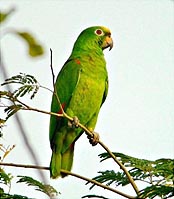
Orange-winged Parrot
Photo by Bill Thompson
|
|
Return to the hotel for breakfast and then from the airport at nearby Ogle, where Red-breasted blackbirds sing and Snail kites patrol, we'll fly by aircraft over the Demerara and Essequibo Rivers and hundreds of miles of unbroken tropical rainforest to land at Annai. Lunch at Rock View Lodge before transferring by Bedford Truck to the Iwokrama River Lodge. Later this afternoon we bird the Screaming Piha Trail near the River Lodge, for Bronzy Jacamar, Chestnut & Waved Woodpecker, Amazonian Antshrike, Gray Antbird, and Strong-billed Woodcreeper. We may also see Gray-winged Trumpeter, Black-tailed, White-tailed, Violaceous and Collared Trogons, Plain-brown, Wedge-billed, White-chinned, Buff-throated, Chestnut-rumped and Barred Woodcreepers.
After Dinner we depart the river lodge by boat for a refreshing drink at Michelle Island overlooking the rapids. After dark we will leave Michelle's Island and take you out on to the river with hopes of finding one or another of its four species of caiman, and listen for nightbirds such as Spectacled Owl, Long tailed Potoo, Zigzag Heron, caiman and other nocturnal wildlife.
Day 3. Birdwatching around Iwokrama; transfer to Atta Rainforest Lodge
Making another early start we will embark on the Essequibo and circumnavigate Indian House Island giving us a chance for dawn song on the river including five species of Tinamou, Marbled Wood-Quail, Band-rumped Swift, White-banded Swallow and its photo-negative, Black-collared Swallows, and Guianan Streaked-Antwren before returning to the River Lodge for breakfast. We then set out by boat for a half hour to the foot of Turtle Mountain. Along the way Harpy Eagle has been seen and we may also see Greater Yellow-headed Vulture, King Vulture, Gray-headed, Double-toothed and Plumbeous Kites and Black-faced Hawk. Here we explore the trails for a few hours first visiting Turtle Ponds where anis, herons and Green and Rufous Kingfisher hunt and then climbing to an elevation of 900 feet for a knockout view of uninterupted forest canopy to the horizon and chances of Green Aracari, White Bellbird or a fly-by of one of five types of Eagles. The trails may reveal Little Chachalaca, Marail Guan, Black Curassow, Squirrel and Black-bellied Cuckoos, Eastern Long-tailed and Reddish Hermits, Blue-crowned Motmot, Guianan White-necked Puffbird, Collared Puffbird, Todd's, Spot-tailed, Long-winged, Rufous-bellied and Brown-bellied Antwrens, White-lored Tyrannulet, Helmeted Pygmy-Tyrant and the Red-and-black Grosbeak,. On the return trip we will bird as we go and hopefully spot Caica, Blue-headed and Blue-cheeked Parrots, Cocoi Heron, Bat Falcon, Lined Forest-Falcon and Pied Lapwing.
 Back to top Back to top 
|
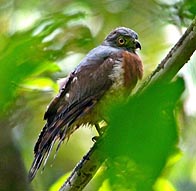
Double-toothed Kite
Photo by Bill Thompson
|
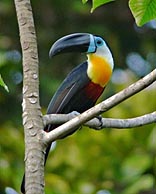
Channel-billed Toucan
Photo by Bill Thompson
|
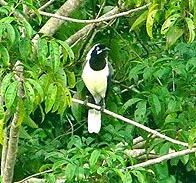
Cayenne Jay
Photo by Bill Thompson
|
|
As the afternoon cools we'll depart the River Lodge by Bedford Truck along the road through the heart of the Iwokrama Forest, where there is a good chance to see the elusive Jaguar. The Iwokrama forest has a reputation for its healthy jaguar populations that seem not to be troubled by the appearance of curious humans. Who knows you might luck-out! The road also offers excellent birding, including a locality known as Mori Scrub, characterized by an unusual low, white sand forest. This supports an interesting assemblage of bird species, among them Rufous-crowned Elaenia, Black Manakin and Red-shouldered Tanager. We will stop along the road at numerous locations and look for species such as Guianan Red-Cotinga, Blue-backed Tanagers, White-winged Potoo, Olive-green Tyrannulet, Rufous-winged Ground-cuckoo and Marail Guan.
Iwokrama Canopy Walkway is a series of suspension bridges and 4 observation decks of up to 30 m (98 ft) in height and 154 m (505 ft) in length. It allows visitors to view the mid and upper-level forest canopy with little disturbance to wildlife. We will be looking for a procession of striking, canopy-dwelling birds such as Crimson Fruitcrow, Caica Parrot, Golden-winged Parakeet, Guianan Toucanet and many more. If we are lucky we may even see the stunning and highly sought-after Pompadour Cotinga. We have a better chance of seeing the commoner Purple-throated Cotinga, as well as a notoriously shy, shaggy monkey, the Guianan Saki. Atta Rainforest Lodge BLD
Days 4 & 5. Wildlife spotting around Atta Raniforest Lodge
Two days of birding from walkway and trails in area. Welcome the dawn chorus from the canopy walkway. Short-tailed Nighthawks settle in for the day, Swifts take to the sky, White throated and Channel-billed Toucans yodel, and Barred Forest Falcons call. We will birdwatch from the mid and upper canopy on the walkway as flocks travel past and look for Paradise Jacamar, White-necked Puffbird, Yellow-throated Woodpecker, Todd's Antwren, Black-tailed and Black-crowned Tityras and Dusky Purpletuft. And we will bird along the jungle trails where antbird flocks include the Guianan endemic Black-throated Antshrike, the spectacular White-plumed Antbird, Spot-winged Antbird, Ferruginous-backed Antbird, Ash-winged Antwen, Long-billed Antwren, McConnell's Flycatcher, Gray-crowned Flycatcher, Plain Xenops and Wedge-billed Woodcreeper. As dusk turns to night, we plan to walk one of the two nights, spent at the walkway on the stretch of road where Rufous Potoo has been seen previously and we will spend some time searching for this elusive species, as well as any other night birds which are calling, before returning to Atta Rainforest Lodge for a late dinner. Atta Rainforest Lodge BLD
|

Guianan Cock-of-the-Rock
Photo by Bill Thompson
|
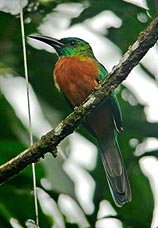
Great Jacamar
Photo by Bill Thompson
|
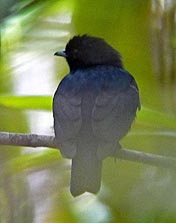
Black Manakin
Photo by Bill Thompson
|
|
Day 6. transfer to Surama Village Surama Eco-Lodge BLD
Early morning birding on the walkway or jungle trails in the hope of seeing Mealy, Orange-winged and Blue-cheeked parrot, Flame-crested Tanager; Slate-colored and Yellow-green grosbeak, Slender-footed Tyrannulet, Black-capped Becard, Buff-checked Greenlet, Purple-breasted Cotinga, Golden-winged Parakeet, Rufous-throated Sapphire, the recently split Guianan Puffbird or even the rare Crimson Fruitcrow. After breakfast we will travel to a rainforest trail to a special locality where Guianian Cock-of-the-Rocks are known to display and nest. This trail is through interesting forest and the guides can show the use of the plants. We will then visit a nearby Harpy Eagle nest. The nest itself is located in a huge emergent tree only a couple of miles from the village and if we are extremely fortunate, we may see one of the adult birds bringing a sloth or monkey to the nest to feed their chick. The trek into the nest site is about an hour each way on a reasonable trail.
We will then continue on to the Amerindian community at Surama. The village of Surama is situated in a small savannah, deep in the rainforest and surrounded by forest clad hills. It was here that Charles Waterton passed through in 1812 in search of the secrets of the useful Wourali poison known as Curare. Waterton was so stunned by this spot that he wrote in his memoirs "The finest park that England boasts falls short of this delightful scene". On our arrival, we will receive a warm welcome from the local people and will be shown to our basic accommodation. Birds characteristic of the Rupununi savannah, such as Fork-tailed Flycatchers and Grassland Sparrow can be seen well, whilst it hopefully won't be too long before our attention is drawn to the far-carrying growling song of the bizarre Capuchinbird. Their bald heads and strange hump-shouldered appearance an unforgettable sight and the Dracula display is one of the most wonderful bird shows I have seen in the Americas.
 Back to top Back to top 
Day 7. Transfer to Karanambu Karanambu Ranch BLD
This morning we will bird around Surama for Red-legged Tinamou, Painted Parakeet, Dusky Parrot, Lilac-tailed Parrotlet. After breakfast we will depart Surama entering the North Rupununi. The Rupununi Savannah is to Guyana what the Gran Sabana is to Venezuela, an extensive area of grassland with termite mounds and scattered woodland and gallery forest. It differs in that much of it is devoted to cattle raising, though the large ranches are not very productive. Indeed, one can travel for hours without seeing a domestic animal of any sort. Fork-tailed Flycatchers, Savannah and Black Collared Hawks patrol the grassland. This morning we will travel along the road as far as Ginep Landing, birding as we go.
From Ginep Landing we will travel by boat and this should give us another excellent opportunity to look for various river-edge, wetland and open country species and we stand a good chance of seeing Black-bellied Whistling-Duck, Jabiru, Wood Stork, Green Ibis, Northern (Crested) Caracara, Black-collared Hawk, Zone-tailed Hawk, Brown-throated Parakeet and Swallow-wing. Depending on the river level, this trip offers an excellent opportunity to look for Giant Otters as there are several family groups which live along this stretch of the Rupununi River. Both Black and Spectacled Caimans also inhabit the river and several species of monkey including Red Howler, White-faced Saki and Squirrel Monkey can be found in the riverside trees. As the ranch is home to Diane McTurk, who has spent much of her life recuperating orphaned Giant Otters, we may also see some of these while at Karanambu.
|
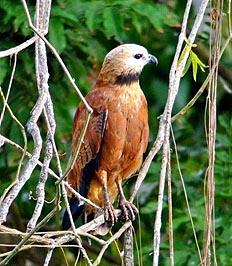
Black-collared Hawk
Photo by Bill Thompson
|
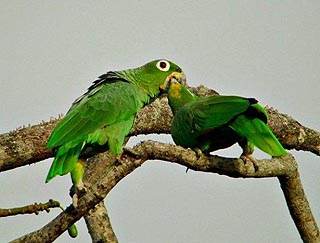
Mealy Parrots
Photo by Bill Thompson
|
|
Day 8. Karanambu Ranch area birding Karanambu Ranch BLD
Another of our targets whilst staying at Karanambu will be the near-threatened Bearded Tachuri, a member of the flycatcher family which has declined markedly in recent years as it requires fairly undisturbed savannah grasslands. We have an excellent chance of finding this species and others we will be looking for include Boat-billed Heron, Pinnated Bittern, Sunbittern, Sharp-tailed Ibis, Green-tailed Jacamar, Spotted Puffbird, Black Nunbird, White-fringed Antwren, Black-chinned and White-bellied Antbirds, Finsch's Euphonia and Rose-breasted Chat.
We also intend to make a boat trip either very early in the morning or late in the afternoon on the nearby Rupununi River to look for Crestless (or Lesser Razor-billed) Curassow. Although this species has not been hunted on the ranch for many years, it remains rare and difficult to find, although our best chance of encountering it will be if we hear a bird giving its low booming call around dawn or dusk. Visit the Crested Doradito at Kwatata for birding. We may also see a Giant Anteater during our stay, as this species is not uncommon around the lodge.
Day 9. Drive to Lethem Savannah Inn BLD
After a final morning at Karanambu, we transfer to Lethem. Birding on the savannahs en route, arriving in Lethem in time for dinner and a relaxing evening in this small frontier town.
Day 10. Ireng River excursion; fly to Kaieteur Falls; fly to Georgetown
Early departure to where we will focus on two birds with restricted ranges in gallery forest which is being replaced by large scale rice cultivation, the endangered Hoary-throated Spinetail and the near-threatened Rio Branco Antbird. We will travel by road to the Takatu and Ireng Rivers and should also encounter species such as Capped Heron, Pale-legged Hornero and various river-edge birds. Although the habitat needs of the antbird and spinetail are seemingly slightly different, they can both be found along a comparatively short stretch of the Ireng River.
We return to Savannah Inn for transfer to airstrip for chartered flight to Kaieteur Falls, where we will spend 3 hrs. Though Venezuela's Angel Falls are greater in total height, their filamentous drop occurs by stages whereas Kaieteur is a single, massive, thundering cataract 100 meters wide created as the Potaro River makes a sheer drop of 228 meters, nearly five times the height of Niagara. The tea-colored blackwater river leaps and magically transforms into a white charging plunge. The spectacle is the more impressive for its remoteness and low visitation, it is possible that we'll be the only persons viewing it. Last visit we were bewitched by a pair of Red-and-green Macaws flying across in front of the falls! Here we will hope to find White-chinned and White-tipped Swifts swirling over the gorge, and perhaps we'll be lucky enough to see the astonishingly colorful Guianan Cock-of-the-Rock, Orange-breasted Falcon, White-tailed Golden throat or Musician Wren. Flight continues to Georgetown. On arrival we will transfer to Cara Lodge. Cara Lodge BL
|

Kaieteur Falls
Photo by Karen Straus
|

Kaieteur Falls
Photo by Karen Straus
|
|
Day 11. Abary Trail excursion, afternoon to Botanical Gardens
After an early breakfast, we will travel eastward from Georgetown to Abary to look for Blood-coloured Woodpecker and Rufous Crab-hawk, the last of the many range-restricted species we will be hoping to find on this tour. We will also look for the poorly known White-bellied Piculet and Guianan Gnatcatcher, both of which can also be found in this area. Return to Georgetown for lunch at a local restaurant. This afternoon we will visit the extensive and beautiful Botanic Garden, where an ornithological highlight is the Blood-colored Woodpecker, an astonishingly colorful Veniliornis found only in the Guianas and even there almost wholly limited to the narrow coastal plain. The gardens also host Pinnated Bittern. Brown-throated Parakeet, Great Horned Owl, Golden-spangled Piculet, White-bellied Piculet. Black-crested Antshrike, Spotted Tody-Flycatcher and Wing-barred Seedeater. A number of macaw and parrot species are also present, including the Festive Parrot. Cara Lodge BL
Day 12. Depart Guyana
Transfer to the airport for international departures from Chedi Jagan International Airport.
 Back to top Back to top 
Tour Information
Price per person: Click here for prices
Included: All lodging, meals, expert bilingual birdguide, transportation, hotel transfer and entrance fees.
Not included: Last night dinner; drinks; tips.
See our Payment and Cancellation Policy page for important information.
|